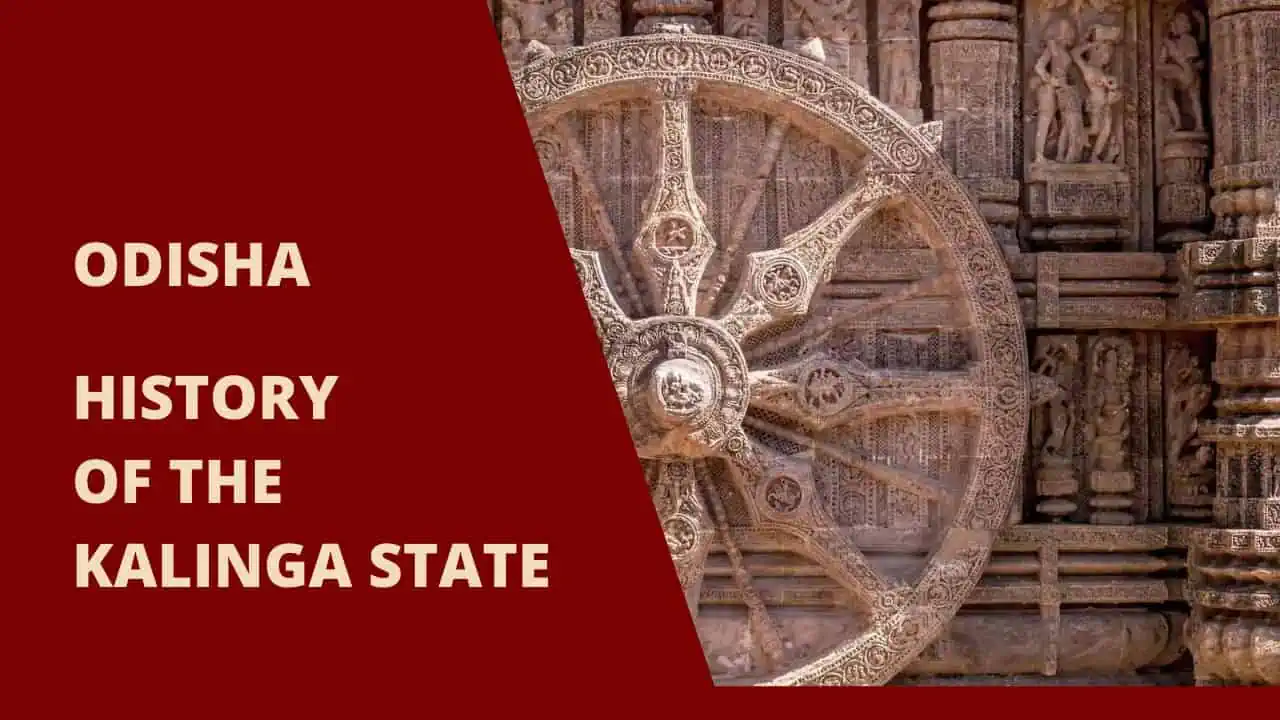History of Odisha – Important Events, Kingdoms, British Raj, and Paika Rebellion
The land of Lord Jagganath, Odisha, has a rich history to its name. Earlier Odisha was called Orissa which later got renamed in 2011 from Orissa to Odisha as people used to mispronounce it often. Let’s look at the history of Odisha in this article.

Odisha was earlier called as ‘Kalinga’ , ‘Utkala’ ,’Mahakantara’ , ‘Tosali’ and many other names.
The Sanskrit word “Odra Vishaya” or “Odra Desa” is where the name Odisha originates. The Mahanadi Valley and the lower course of the Subarnarekha River comprised the boundaries of the prehistoric province known as “Odra desa” or “Or-desa.” It included all of the current Cuttack and Sambalpur districts as well as a piece of Midnapore. Its borders were Gondwana to the west, the sea to the east, the wild hill realms of Jashpur and Singhbhum to the north, and Ganjam to the south.
The history of Odisha is long and illustrious, with evidence of human habitation dating back more than 1.5 million years. The Mahabharata culture, known for its use of iron, was one of the earliest known civilizations in the region. The Mauryas, Guptas, and Shungas were among the empires that rose and fell in Odisha, but it was the formidable Kalinga Empire that left a lasting impact.
During the Middle Ages, strong Hindu kingdoms like the Eastern Ganga Dynasty and the Gajapati Kingdom ruled Odisha, and the region was a significant hub for the Jain and Buddhist religions. The Mughal Empire subjugated Odisha in the 16th century, but its dominance was short-lived, and the region joined the British Raj in the 18th century.
Under the British administration, Odisha experienced significant economic and social advancement, including the introduction of new farming practices and crops that raised agricultural productivity. Today, Odisha is renowned for its rich cultural legacy, stunning beaches, and delectable cuisine.
The state has a fascinating history, and its heritage sites and enthralling views attract tourists from around the world. The Jagannath Rath Yatra and the Puri Beach Festival are among the many attractions that draw visitors to the region each year. Odisha’s history is a testament to the resilience and diversity of its people and their ongoing efforts to preserve their cultural heritage.
The Early History of Odisha
As per Govt of Odisha website , Kalinga is known to be a powerful kingdom as early as the time of the Kurukshetra battle. Srutayudha, the king of the Kalinga joined the camp of the Kourava in the battle and was killed in the battle by Bhimasena with his two heroic sons: Bhanumana and Ketumana.
After the Mahabharata War, a new Kshetriya dynasty ruled over Kalinga and it is known from the Buddhist work ‘Mahagovinda Suttanta’ that the glory and power of Kalinga were restored within a short period. According to the Puranas 32 Kshetriya kings ruled over Kalinga after the Mahabharata War up to the time of Mahapadmananda who ascended the throne of Magadha in 362 B. C.
Important Events in the History of Odisha
Some of the important events in the history of Odisha include:
- The Kalinga War: This was a major war fought between the Mauryan Empire and the Kingdom of Kalinga in the 3rd century BCE. The war resulted in the conquest of Kalinga by the Mauryan Emperor Ashoka, who was so moved by the destruction and suffering caused by the war that he converted to Buddhism.
- The Rule of the Bhauma Kings: The Bhauma kings ruled over Odisha from the 7th to the 11th century CE and were known for their support of Hinduism and the construction of temples and other religious structures.
- The Maratha Invasion: In the 18th century, Odisha was invaded by the Maratha Empire, which resulted in the decline of the Bhauma kings and the rise of the Maratha rule in the region.
- The British Raj: In the 19th century, Odisha came under the control of the British Raj, which continued until India’s independence in 1947.
- The Cyclone of 1999: In 1999, Odisha was hit by a severe cyclone that caused widespread destruction and loss of life. This was one of the worst natural disasters in the history of the state.
Consider reading: Kalinga War in Odisha
Major Odisha Kingdoms in the History of Odisha
Some of the major kingdoms that have ruled over Odisha include:
- The Kalinga Kingdom: The Kalinga Kingdom was one of the earliest and most powerful kingdoms in the history of Odisha. It was ruled by the Chedi dynasty and was known for its maritime trade and military power.
- The Bhauma Kingdom: The Bhauma Kingdom was a Hindu kingdom that ruled over Odisha from the 7th to the 11th century CE. It was known for its support of Hinduism and the construction of temples and other religious structures.
- The Ganga Kingdom: The Ganga Kingdom was a Hindu kingdom that ruled over Odisha from the 11th to the 15th century CE. It was known for its support of Hinduism and the construction of temples and other religious structures.
- The Maratha Kingdom: The Maratha Kingdom was a Hindu kingdom that ruled over Odisha in the 18th century. It was known for its support of Hinduism and the construction of temples and other religious structures.
- The British Raj: In the 19th century, Odisha came under the control of the British Raj, which continued until India’s independence in 1947.
Nanda Kingdom Rule in the History of Odisha
The final of the 32 Kshetriya rulers was overthrown and slain by Mahapadmananda, who also added Kalinga to his vast dominion. Despite losing her independence, Kalinga experienced economic success under the Nanda dynasty. To end the starvation in Kalinga, Mahapadmananda started irrigation projects.
The abundance of pre-Mauryan black polished pottery and four-symbol punch-marked coins discovered in Asurgarh in the Kalahandi district and Sonapur in Bolangir district reveal the prosperous economic climate during the Nanda era.
Following Mahapadmananda, each of his eight sons took the throne in turn, until the final Nanda king was deposed by Chandragupta Maurya when he discovered the Maurya reign in Magadha. When Chandragupta overthrew the last Nanda ruler, Kalinga declared her independence and worked to strengthen her position as a global force.
The Nanda Kingdom had a significant impact on the History of Odisha.
Mauryan Rule in the History of Odisha
In 261 B.C., Asoka, the son of Vindusara, invaded Kalinga and eventually took control of the region. The history of Odisha benefited from the contributions of Asoka. The Kalinga War was of epic proportions, with up to 1,000,000 killed, 150,000 captured, and an additional 1,000,000 dying as a result of the conflict. Asoka was strongly impacted by the horrific carnage brought on by this conflict and became a Buddhist.
The fighting forces of the Atavika territory, a hilly region to Kalinga’s west, were used by Kalinga during the conflict. Asoka abandoned his plans for further conquest after annexing the coastal province of Kalinga to his realm. He made an effort to appease the unconquered Atavika people and hoped to win their hearts through love. Following the Kalinga War, Asoka adhered to the Dharmavijaya philosophy.
With a Kumara (Viceroy) in charge, Kalinga became one of the administrative divisions under the Magadha empire. Its headquarters were in Tosali. In the second headquarters, Rajavachanika, a top executive officer, was stationed in Samapa. In addition, Tosali served as the provincial capital of the highest judicial body.
Asoka actively tried to establish Maurya control in the recently captured region and aimed to create a charitable government with a well-organized bureaucracy. Under his sponsorship, Buddhism spread throughout Kalinga and eventually took over as the official religion, while the craft of stone construction advanced significantly. To teach the populace about his governance and religious ideals, edicts were inscribed on the rocks at Dhauli and Jaugada. The Maurya empire lasted until 185 B.C. with Asoka’s death in 232 B.C.
Mahameghavahana Kharavela rule in the History of Odisha
The early history of Odisha is marked by the attainment of independence by Kalinga under the leadership of Chedi Chief Mahameghavana in the first century B.C. Kharavela, the third ruler of the dynasty, is a prominent figure in the history of Odisha.
The Hatigumpha inscription in Udayagiri caves provides detailed chronicles of Kharavela’s life and achievements. From restoring cyclone-damaged city gates to invading neighboring kingdoms, Kharavela left a significant mark on the political and cultural landscape of Odisha. He is credited with renovating the aqueduct and purging the Indo-Greeks out of Mathura, an important seat of Jain religion and culture.
Kharavela’s restoration of Kalinga Jina, which had been removed three hundred years prior, is regarded as one of his greatest accomplishments. His thirteenth regnal year saw the construction of cave habitations for Jain monks in the Kumari highlands. Kharavela’s legacy remains a crucial part of the history of Odisha, chronicled in the Hatigumpha inscription.
The British Raj in the History of Odisha
British rule over the Indian subcontinent from 1858 to 1947 was known as the British Raj, often known as British India. Odisha was under the control of the British Raj at the time.
In order to get a foothold in the lucrative Indian market, the British first traveled to India as traders in the early 17th century. They built forts and trading posts around the nation, especially in Odisha, and slowly started to increase their power.
The British East India Company received permission to levy taxes in some regions of India, including Odisha, towards the beginning of the 18th century. As a result, the firm gained a large amount of influence and was able to essentially dominate a sizable portion of the nation.
Over time, the East India Company ran afoul of both regional tyrants and other European countries with a presence in India, such as the French. The Anglo-Maratha Wars and the Anglo-Mysore Wars were among the wars and conflicts that resulted from this.
The British started to take control of more and more areas of India in the early 19th century, including Odisha. The last Gajapati ruler of Odisha was overthrown by the British in 1803, and they thereafter assumed control of the territory.
The British Raj was formally created in 1853 when the British government replaced the East India Company as the country’s administrator. Odisha and the rest of India joined the British Raj at that point, and the British began to directly control India.
The British Raj has had a significant influence on the history of Odisha.
The Paika Rebellion
An important moment in the history of Odisha was the Paika Rebellion in 1817. One of the earliest manifestations of organized resistance to British imperialism in India was a rebellion against British rule.
The Gajapati monarchs of Odisha have historically used the Paikas, a warrior class of landowners, as their army. The Paikas were among the first to fight when the British East India Company started to impose its rule over the area in the early 19th century.
The last Gajapati ruler was overthrown by the British in 1803, and they then gained control of Odisha’s government. This action incensed the Paikas, who had long been devoted to the Gajapati monarchs, and they started to plan a revolt.
The Paikas revolted against the British in 1817 under the leadership of Buxi Jagabandhu, their chief. They launched several assaults against British outposts and garrisons, managing for a while to hold their own against the British army.
Although they fought for months, the Paikas were finally unable to beat the British, and the uprising was put down. Many Paikas were slain or exiled, and Buxi Jagabandhu was seized and imprisoned.
Like reading this article? Like our Incredible Odisha page on Facebook.
FAQ on the History of Odisha
What was Odisha’s old name?
The name Odisha (formerly Orissa) refers to the current state of India.
But in different periods of history, the region and parts of the region were known by different names. Some of the other names the region has been known by include:
* Kalinga
* Udra
* Utkala
* Atavikta
* Odra desha
* Oddadurga
* HirakhandaWho was the first king of Odisha?
The first king of Odisha was Anangabhimadeva III.
Why is Odisha famous?
Odisha is famous for its temples and dance forms. The temples of Odisha are known for their intricate carvings and architecture, and the dance form Odissi is known for its graceful movements.
Odisha is also famous for Puri Jagannath Rath Yatra.What is Odisha’s famous food?
Some of the most famous foods from Odisha include rasagola (a type of sweet), pakhala (a type of rice dish), and dalma (a type of dal).
When was Odisha formed?
The state of Odisha was formed on April 1, 1936. Orissa Province was a province of British India created in April 1936 by the partitioning of the Bihar and Orissa Province. Its territory corresponds with the modern-day State of Odisha.
Who was the first chief minister of Odisha?
Harekrushna Mahatab was the first chief minister of Odisha state.
How old is the history of Odisha?
The history of Odisha is over 1.5 million years old.
How did British rule affect Odisha?
Odisha was significantly impacted by British control. The British also constructed a number of schools and colleges in the area, as well as new crops and farming methods that considerably enhanced agricultural productivity.
What were some important events in the history of Odisha?
ome important events in the history of Odisha include the conquest of the Kalinga Empire by the Mauryan Emperor Ashoka, the rise of the Eastern Ganga Dynasty and the Gajapati Kingdom, and the conquest of the region by the Mughal Empire.
How many districts were part of Odisha when the state was formed?
When Odisha was formed as a state in 1936, it had 17 districts. Today, the state has 30 districts. This number has changed over time due to the creation of new districts and changes in district boundaries.



